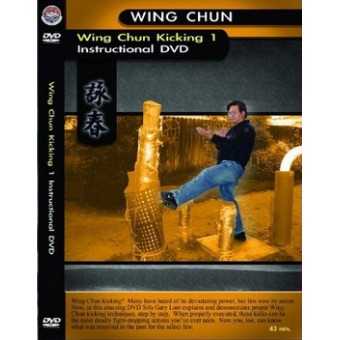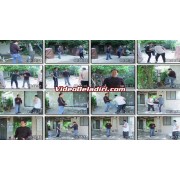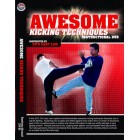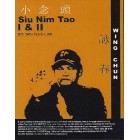Wing Chun Kicking Instructional-Gary Lam
It is usually thought by non-Wing Chun practitioners that that Wing Chun does not have kicking, but indeed there are eight distinct kicks within the system. Kicking is usually not brought into action because of the effectiveness of Wing Chun hands; so it is easy to see the reason for the confusion about Wing Chun kicking. Further, hands are easy to keep up, but legs weigh more and gravity takes over as well as the need for proper balance. Certainly as Sifu Lam has mentioned in other videos legs are very powerful, but control of an opponent via the hands with the proper use of the body and structure can be quite powerful. Still, Wing Chun is a complete system and so kicking is also a vital component although perhaps utilized by many practitioners to a lesser degree than Wing Chun hands.
The foundation for Wing Chun kicking is laid in the "Sil Lim Tau" form. However, a kick is not actually shown by the forms until "Cham Kiu" and subsequently kicking is fully expanded within the "Mook Yan Jong" form. The DVD "Wing Chun Kicking 1" is broken into six chapters. The DVD opens with demonstrations of both pole work and Baat Jam Do work followed by Sifu Lam working on triangular kicking. The Wing Chun "kicking wooden dummy," not to be confused with the Mook Yan Jong, has three components for triangle kicking so that kicks can be launched from any angle.
In the second section of the DVD Sifu Lam demonstrates the eight different kicks of Wong Shun Leung Wing Chun initially in free form followed up by a demonstration with a student. The free form demonstration is useful to show angles of the kick. As usual the finer points of the kicking are discussed and then well demonstrated with the aid of a student. The use of an opponent effectively shows how Wing Chun kicking can stop, damage, or incapacitate that opponent, which is a little harder to see in free form as well as when applied with the Mook Yan Jong.
The third section covers incorporating Wing Chun kicking training with Pak Sau. Pak Sau is usually a Wing Chun exercise for hands alone (of course body, technique, form, structure and proper advancing should be observed), but in this section Sifu Lam has two students demonstrate the eight kicks he initially demonstrated earlier in the DVD in combination with Pak Sau. On initial viewing some of the demonstrations may not look formidable. Sifu Lam does show why the exercises are effective. The idea of using hand strikes and kicks simultaneously or hand blocks with kicking strikes or hand strikes with kicking blocks is repeatedly shown. Multiple contact points are of course also shown. At the end of this sequence Sifu Lam states that this is not inside of traditional Wing Chun, but due to complexity of modern fighting, the combination of Pac Sau and kicks can be quite effective.
The fourth section shows Sifu Lam at work on the Mook Yan Jong and each of the eight kicks are then worked with a student. The Eight kicks of Mook Yan Jong can be broken into three sections according to Sifu Lam. It should be noted that Sifu Lam has added one kick that his Sifu took out of the Yip Man form. This is mentioned in his second Mook Yan Jong DVD, "Wing Chun Combat Applications." Again finer points of the Mook Yan Jong form kicks are shown such as how the side kick has a variation, which is also correct. The difference between the two variations depends upon the distance of the attacker, which will either be closer or further.
Section five of the DVD demonstrates traditional solo and duo kicking training. This section is distinct from other sections in that the student uses successive kicking down a linear path. Demonstrated in this section is also what is referred to as "Rickshaw Kicking." "Rickshaw kicking" training is used when a practitioner finds that his leg has been capture after a kick has been delivered. Here a partner is needed to train the reality of a captured kick. The idea is that the leg is cocked (triangle) in preparation for returning the leg to the ground, while simultaneously landing blows and moving forward. According, to Sifu Lam the secret of Wing Chun kicking is that within Wing Chun kicking does not stop – the kick goes forward and is not retracted. Hence, more than one kick can be delivered with the same leg. Further, because of the way Wing Chun kicks are delivered a kick can become a step and a step a kick or the kick a series of kicks.
The sixth and final section of the DVD concludes with Sifu Lam exploring the eight Wing Chun Kicks as utilized in fighting. Sifu Lam explores possible counter (again Wing Chun is a concept-oriented martial art) to a lower kick, side kick, middle kick and high kick that an opponent might deliver. Sifu Lam states that the most effective and powerful kicks in fighting are those kicks that do not rise above the midsection, which is completely in line with Wing Chun theory and concepts of minimizing distance and using simple techniques.
Also in this section Sifu Lam addresses the point that many fighters fear a kick and then proceeds to show how to take, dissipate, deflect or stop the force of a kick as well as launching multiple kicks either when the first kick is stopped or the Wing Chun practitioner has the opportunity to launch multiple kicks. Here the finer points of using knees, closed hands (to prevent finger breakage), cocked elbow are demonstrated. Sifu Lam shows these techniques used to counter by having the one of his students launch kicks progressing from low to higher levels all the way up to kicks that have been launched to the head of the Wing Chun practitioner. In this section Sifu Lam shows some truly useful techniques.
The DVD "Wing Chun Kicking 1" shows that there are many uses for a kick within Wing Chun. A kick can be used to stop, damage, break, deflect, or used as an anchor, foot, or pining point of the opponent's foot, ankle, knee or thigh. Kicks in Wing Chun are fluid; multiple kicks can follow the initial kick or step forward. A kick is not retracted, but goes forward. Kicks are also launched from multiple angles within Wing Chun either due to the angle of the attacker or the response of the Wing Chun practitioner. Most importantly kicks can also have multiple actions launched along with a kick. An example of this is the side kick launched with a Tan Sau to the forearm and a punch to the rib cage – three points of contact.
"Wing Chun kicking 1" is approximately 43 minutes. The lighting is fairly good, although there are some parts of the video which demonstrates blow out (sky scenes or walls), but these do not interfere with the techniques shown. The sound is also good, but there are occasional glitches. Overall the video has a good feel and has the marks of a superior, but not perfect production.
"Wing Chun kicking 1" is recommended for intermediate to advanced Wing Chun practitioners. As usual, any level of Wing Chun practitioner may benefit from some parts of the DVD, but to fully incorporate all of the ideas and techniques into training would require that the student or practitioner be of intermediate to advance level. This DVD is heartily recommended without reservation and is arguably the fifth (behind the four forms DVDs, especially since Sifu Lam has not yet covered the weapons forms on DVD yet) most useful DVD is Sifu Lam's DVD library.
kualitas DVDrip
durasi 43 menit
detil lihat dipreview
Wing Chun Kicking Instructional-Gary Lam
- Product Code: win103
- Availability: In Stock
-
Rp.40,000




